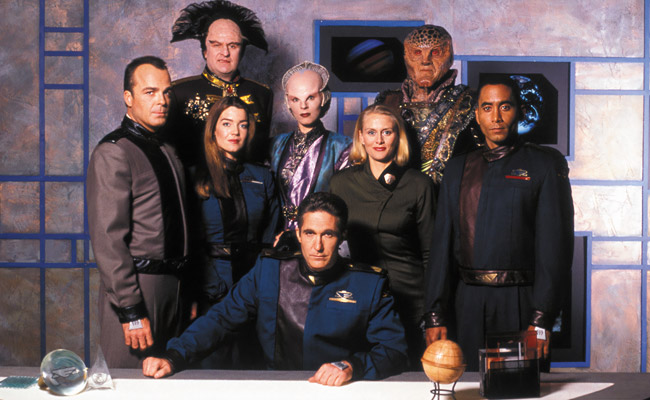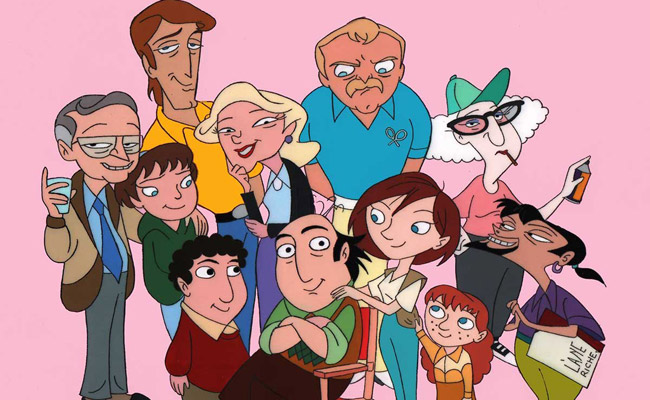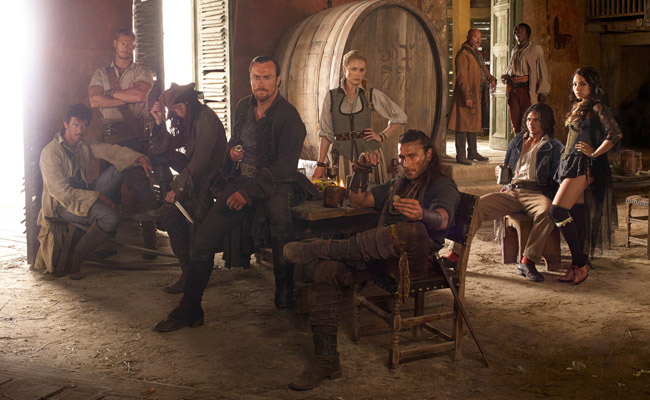
Babylonian Productions, Inc.
It was a fairly good week for new TV series premieres, with several new series making their debuts that went on to long runs. 1954 produced a TV Western series whose star would go on to be better known for a popular primetime soap nearly 30 years later, while 1964 and 1974 sat out the week. 1984 gave us a show whose real star was a souped-up helicopter, 2004 had a reality series about a famous couple about to wed, and 2014 had a long-running reality dating series, a reality show about a famous family’s fast food franchise, a female buddy comedy series, and a drama about pirates. The standout year this week was 1994 with a cult sketch comedy series, a cult animated series, and a sci-fi series that broke new ground in many areas and has developed a cult of devoted followers to this day. Read on to learn more and tell us if any of your favorites are celebrating milestones this week!
1954
- January 23 – Stories of the Century (Syndication, One season, 39 episodes)
Stories of the Century was a Western historical fiction series that starred Jim Davis, who would be better known as Jock Ewing in the popular primetime soap Dallas. Davis’ co-star was Mary Castle, who was replaced after 26 episodes with Kristine Miller. Davis’ character, Matt Clark, was fictional but the events in the series were generally real. It was the first TV production from Republic Pictures. Guest stars included Marie Windsor, Lee Van Cleef, Slim Pickens, Steve Brodie, John Dehner and Richard Jaeckel. It was the first Western series to win the Emmy Award for Western or Adventure Series. In later reruns, the series was retitled The Fast Guns. The series has fallen into the public domain.
1964
- No new series premiered this week in 1964.
1974
- No new series premiered this week in 1974.
1984

Belisarius Productions
- January 22 – Airwolf (CBS, Three seasons, 55 episodes / USA Network, One season, 24 episodes)
After its initial broadcast, the two-hour Airwolf pilot TV movie was split into two episodes, bringing the Syndicated version of the series 80 episodes. A re-edited version of the pilot was released to home video in the UK and several other countries, and it received a theatrical release in Indonesia. Creator Donald P. Bellisario toyed with the idea for the series in what became a backdoor pilot episode of Magnum, P.I. that starred William Lucking. The series didn’t sell and Bellisario reworked it into what became Airwolf. Network interference in the show’s tone and casting led Bellisario to quit the series and leave Universal, and the changes between each of the first three seasons caused ratings to fall and the show to be cancelled. USA picked the show up for a fourth season and completely recast it as the original actors were too expensive to retain. Only star Jan-Michael Vincent’s Stringfellow Hawke appeared in the first episode in what amounted to a cameo. Ernest Borgnine’s character was killed off with the use of a body double seen only from behind, the character Archangel was suddenly sent overseas, and ‘The Firm” was replaced with ‘The Company’. Barry Van Dyke’s character St. John Hawke (originally played by Christopher Connelly), missing in action since the Vietnam War, is revealed to be alive, having been working as a deep undercover agent for the previous three seasons. He replaced Stringfellow as the main character. Production moved to Vancouver with a budget one-third of what the CBS budget was, and production no longer had access to the original helicopter, so all in-flight footage was recycled from previous seasons. According to Michele Scarabelli, all 24 scripts were written before anyone had been cast, leaving the actors little room to develop their characters.
1994

Gracie Films
- January 21 – The State (MTV, Four seasons, 25 episodes, 1 special)
- January 26 – Babylon 5 (PTEN, Four seasons / TNT, One season, 110 episodes)
- January 26 – The Critic (ABC, One season, 13 episodes / FOX, One season, 10 episodes)
The State‘s 11 cast members featured just one woman, Kerri Kenney. In many sketched that required a female character, the male actors appeared in drag. In the sketch ‘Drag Dad’, Kenney played a male character which was part of the running joke of the sketch. After the show ended, many members of The State (the name of the comedy troupe) continued to work together on projects including Reno 911! and Wet Hot American Summer. CBS wanted to buy the show to compete against NBC’s Saturday Night Live and aired The State’s 43rd Annual All-Star Halloween Special in 1995. Despite fairly good reviews, the special performed poorly due to a lack of promotion on the part of the network. The troupe has posted an official statement that the show has never formally been cancelled — MTV offered a contract for a guaranteed 65 additional episodes — but they decided to pursue other interests and establish The State as an entity apart from any employer or network … against their agent’s advice. The cast did not want to create recurring characters, but were pressured by MTV to emulate SNL. To fight back, some of the recurring characters were created as satires of recurring characters, such as the character ‘Louie’ (Ken Marino) who also had catch-phrases.
Babylon 5 began with a TV movie pilot, Babylon 5: The Gathering, which aired on February 22, 1993. The series was commissioned in May for Warner Bros. new Prime Time Entertainment Network. The series was conceived as a ‘novel for television’ with each episode being a ‘chapter’, with a five year story arc set between 2257 and 2262. With actors having difficulties with the heavy make-up required to play the various alien characters, producers had a group of actors (as many as 12) who could handle the make-up and play different characters in different episodes. They were unofficially known as the ‘Babylon 5 Alien Rep Group’. Each season takes place during one year of the story, with seasons carrying a subtitle that is shared with an episode central to the season’s plot. Warner Bros. was skeptical that American audiences had the attention span for a season long story arc, and were concerned local stations carrying the show would air episodes out of order. Creator J. Michael Straczynski had proof that the stations aired shows in episode order to track broadcast for royalties, but could not guarantee audiences would be engaged. The studio also pointed out that no science fiction series had ever gone beyond three seasons, but they greenlit the pilot with Straczynski setting out to prove them wrong. Straczynski wrote 92 of the 110 episodes, including all 44 episodes of Seasons 3 and 4, something no other writer in television history had accomplished. Writers including Neil Gaiman, D.C. Fontana and David Gerrold contributed scripts, and creative consultant Harlan Ellison also received story credit for two episodes. Each writer was given the overarching storyline, scripts were written six episodes in advance and changes could not be made once production started to enable to the show to be produced consistently under budget. Straczynski built in ‘trap doors’ in the event an actor was not available for a particular episode to easily explain their absence, something he’d had in mind from the start knowing such events were probable so as not to impact the storyline. He also went light on the five-year story in Season 1 so as not to overwhelm the audience, but he did drop in scenes that would become important later on. He also did not give the actors much information about where their stories were heading so they would work in the process rather than play the result. When Warner Bros. shut down PTEN during production of the fourth season, the fifth and final season was in doubt forcing Straczynski to make modifications to the Season 4 story to bring the series to a conclusion should it not be renewed elsewhere, but still needing about 27 episodes to tell the story properly. The TNT network, a Warner property, commissioned two TV movies that would include material written for the fifth season and set up the sequel series Crusade. The intended series finale was filmed during Season 4 as a precaution against cancellation, but when TNT picked up a fifth season that episode acted as the series finale at the end of Season 5 as intended, with a new Season 4 finale added (the series finale felt oddly out of place as Claudia Christian had exited the series at the end of Season 4 but appears in the finale, while Tracy Scoggins does not appear as she joined the show in Season 5). A decision was made early on to depict most alien species as humanoid to cut down on the use of puppets and animatronics, which Straczynski felt could not convey real emotion without a person inside the costume. Pure CGI characters were discounted due to the massive rendering power required.
With HDTV on the horizon the live-action portions of Babylon 5 were shot in 16:9 widescreen format on film rather than tradition 4:3, but cropped to 4:3 for broadcast. It was one of the first TV series to use computer graphics for the visual effects, however the VFX were rendered in standard definition and output to video, making true HD presentations of the series nearly impossible. Straczynski has said the entire series cost about $90 million for the 110 episodes, and while it was profitable for PTEN, it remained $30 million in the red and he never made any profits. The series won two Emmy Awards for Visual Effects and Hairstyling, and received six additional technical Emmy nominations during its run. Straczynski had previously taken his outline to Paramount, which declined to pick it up but later announced production of Star Trek: Deep Space Nine, which was also set mostly on a space station with similar themes to Babylon 5. Straczynski felt certain that DS9 creators Rick Berman and Michael Piller had not seen his material, but he suspected Paramount execs used his ideas to steer development of the show. He and Warner Bros. opted not to file a lawsuit feeling any action would damage both series, but B5 cast member Patricia Tallman stated in a 2017 interview that there was a legal case and an out-of-court settlement with Paramount.
Straczynski has also noted that his novel five-year story arc for Babylon 5 has become the norm in sci-fi shows that followed like Battlestar Galactica and Lost. The series also spawned three TV films, plus a re-edited version of The Gathering and a pilot movie for Crusade, which was cancelled after 13 episodes. The Sci-Fi Channel acquired rerun rights to the show in 2000 and produced another TV movie pilot in 2002, The Legend of the Rangers, which did not get picked up as a series. The first of a planned anthology of straight-to-DVD shorts, The Lost Tales, was released in 2007 but no other releases followed due to funding issues. A Babylon 5 movie was announced in 2014 at Comic-Con, but has not moved forward as Straczynski holds the movie rights but Warner Bros. holds the intellectual property rights to the TV series and no other studio would want to handle a film without the TV rights. A reboot of the show was announced for The CW in 2021 and was still in development throughout the change of network ownership. The 2023 writers strike put the project on hold. A direct-to-video animated movie, Babylon 5: The Road Home, featuring the voices of most of the surviving cast members was released in 2023.
The Critic was born out of an idea presented to The Simpsons showrunners Al Jean and Mike Reiss by creator Matt Groening who pitched them a Krusty the Clown spin-off series. They presented their ideas but Groening turned them down, wanting a live-action series starring Krusty’s voice actor Dan Castellaneta. When executive producer James L. Brooks approached them with an idea for a sitcom based on a morning television program, they adapted their Krusty pitch which featured many of the same elements, and Brooks suggested Jon Lovitz as the lead, based on his performance in A League of Their Own. Lovitz turned the series down due to commitments to three other film projects, but when it went from live-action to animation he was able to participate. The show sometimes included appearances of real life critics, such as Gene Shallit, Rex Reed, Gene Siskel, and Roger Ebert, who provided their own voices. The show was the first major non-family animated sitcom on primetime TV, and when it moved to FOX there was a ‘shameless plug’ crossover episode with The Simpsons, and began airing after the popular series which improved the show’s ratings. FOX then moved the show to a new time slot after five episodes then cancelled the show in May 1995 even though nine scripts had already been written for a third season. A plan was in the works to move the show, again, to UPN but an agreement was not reached and FOX never officially cancelled the series until much later. The show returned in webisode form from 2000-2001 with 10 three-to-five minute installments. The series has been regarded as one of the best cancelled too soon.
2004
- January 21 – ‘Til Death Do Us Part: Carmen and Dave (MTV, One season, 7 episodes)
- January 23 – Dave the Barbarian (Disney Channel, One season, 21 episodes)
‘Til Death Do Us Part: Carmen and Dave focused on the preparations for the wedding of Carmen Elektra and Dave Navarro, an event they had been putting off but were forced to move forward with for the series. Navarro stated that the reality of the situation was impossible to achieve because of an eight-person camera crew in their house. The couple divorced in 2007, but did not blame the stress of making the series or the ‘MTV curse’, which was evidenced by the breakup of Nick Lachey and Jessica Simpson during the making of their MTV reality show.
2014

Platinum Dunes
- January 21 – Opposite Worlds (Syfy, One season, 12 episodes)
- January 21 – Are You the One? (MTV, Nine seasons, 98 episodes)
- January 22 – Broad City (Comedy Central, Five seasons, 50 episodes)
- January 22 – Wahlburgers (A&E, Ten seasons, 95 episodes)
- January 22 – Dark Rye (Pivot, One season, 20 episodes)
- January 23 – Rake (Fox, One season, 13 episodes)
- January 25 – Black Sails (Starz, Four seasons, 38 episodes)
- January 27 – Rods N’ Wheels (Discovery Channel, One season, 6 episodes)
Opposite Worlds was a game show based on the successful Chilean series Mundos Opuestos, and was hosted by Luke Tipple. The series was aired twice a week, on Tuesdays and Wednesdays, for six weeks with the Wednesday episode airing live, the first Syfy series to do so.
The eighth season of Are You the One? was the first dating series to exclusively feature openly LGBTQ and sexually fluid contestants, a decision that was met with critical acclaim but was less-than-popular with viewers, becoming the last season of the series to be broadcast on MTV to date. The series was revived in 2023 for Paramount+ with Kamie Crawford as the new host. The series had previously been hosted by Ryan Devlin and Terrence J. A spin-off series, Are You the One? Second Chances aired in 2017 with Karamo Brown as host.
Broad City was developed by stars Ilana Glazer and Abbi Jacobson from their independent 2009-2011 web series of the same name, and draws inspiration from their real-life friendship. The series was originally pitched to and bought by FX, but the network passed on it a year later for being ‘too girly’. Comedy Central picked it up in 2012. Guest stars during the show’s run included Wanda Sykes, Kelly Ripa, Amy Poehler, Fran Drescher, Shania Twain, Hillary Clinton, and RuPaul. Glazer and Jacobson decided to end the show after five seasons not wanting to go until it was cancelled by the network.
Wahlburgers received Emmy nominations in 2014 and 2015 for Outstanding Unstructured Reality Program, and spawned the spin-off Donnie Loves Jenny, which aired for three seasons in 2015-2016.
Rake was an American television adaptation of the Australian series of the same name, which starred Greg Kinnear who was also one of the show’s producers along with Richard Roxburgh, who starred in the original series. FOX aired the series on Thursday, then moved it to Fridays due to poor ratings, eventually airing the last two episodes on Saturdays. As was the norm with FOX at the time, episodes were aired out of order with the first episode airing fourth.
Black Sails was written as a prequel to Robert Louis Stevenson’s 1883 novel Treasure Island. The first episode debuted for free on YouTube a week before the series premiere on Starz on January 25, 2014. The series was filmed in Cape Town, South Africa. The opening theme by Bear McCreary includes the period accurate instrument, the hurdy-gurdy. It took 300 workers to build just one of the ships used on the show. The series received ten Primetime Creative Arts Emmy Awards nominations during its run, winning three for Sound Editing, Visual Effects in a Supporting Role, and Supporting Visual Effects in a Photoreal Episode.
